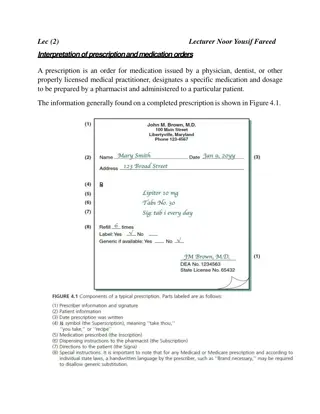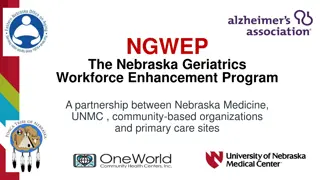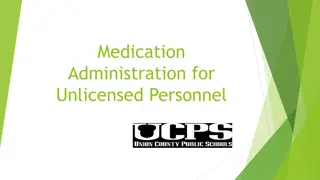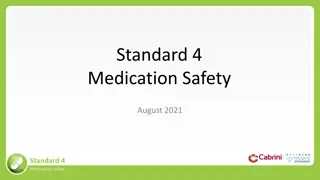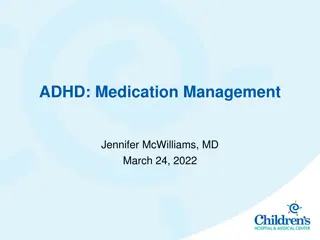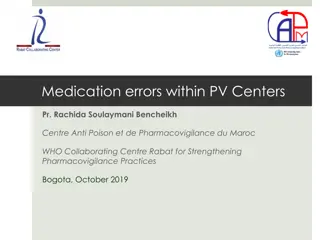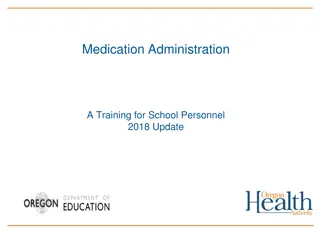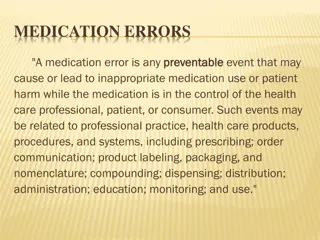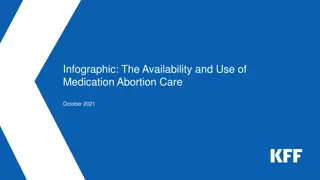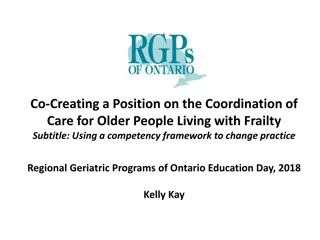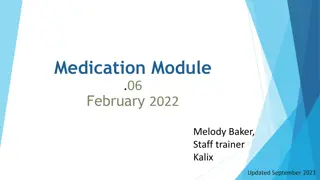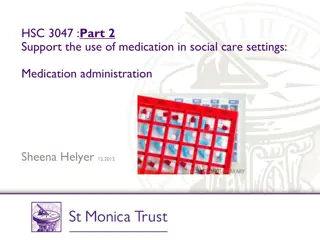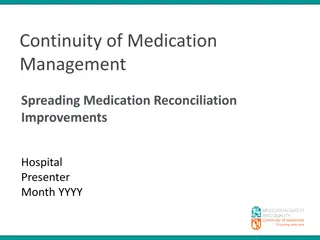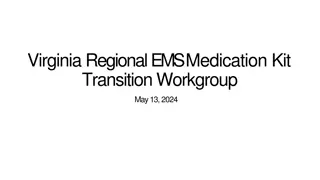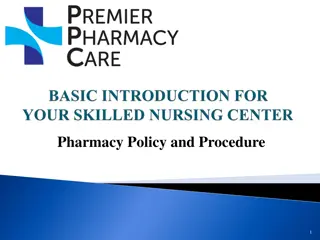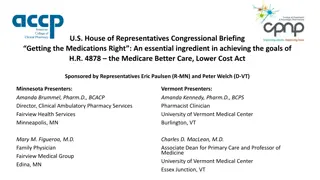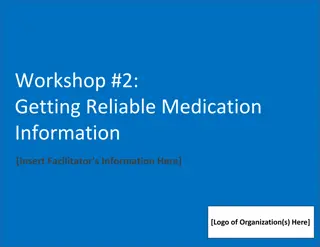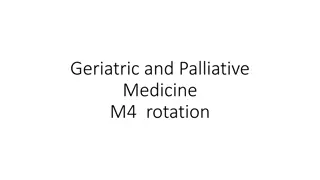Comprehensive Guide to Geriatric Medication Management
Explore the essentials of geriatric pharmacology, including the impact of polypharmacy, medication-related problems in the elderly, and practical factors affecting medication management. Learn about medication reconciliation, Beers criteria, and common medications affecting seniors' health and well-being.
Download Presentation

Please find below an Image/Link to download the presentation.
The content on the website is provided AS IS for your information and personal use only. It may not be sold, licensed, or shared on other websites without obtaining consent from the author. Download presentation by click this link. If you encounter any issues during the download, it is possible that the publisher has removed the file from their server.
E N D
Presentation Transcript
The Basics of Geriatric Pharmacology Tatyana Gurvich, Pharm.D., BCGP Rory Kim, Pharm.D., MACM, BCACP USC School of Pharmacy
Learning Objectives Define the terms polypharmacy and prescribing/medication cascade Describe the elements of a thorough medication history and reconciliation Develop strategies to collect a thorough medication history/reconciliation Utilize the Beers criteria to identify potentially inappropriate use of medication in the elderly Identify common medications that may affect nutrition (appetite, taste, weight, or dry mouth)
Medication use in the elderly Adults 65 years old make up 12% of population, but account for 34% of all prescriptions https://www.cdc.gov/nchs/data/databriefs/db42.htm
Medication Related Problems: Common, Costly, Preventable Total estimated healthcare expenditure related to potentially inappropriate medications is $7.2 billion 27% of adverse events in primary care offices 37% of adverse events in nursing homes 380,000-450,000 adverse drug events occur annually in hospitals JAGS 2012 Arch Int Med 2009 https://www.beckershospitalreview.com/quality/8-statistics-on-adverse-events-at-skilled-nursing-homes.html
Medication management in older adults Increased risk of adverse effects: Multiple disease states Multiple chronic medications Altered response to medications (pharmacokinetics/ pharmacodynamics) Drug-drug interactions Adverse drug reactions
Practical Contributing Factors Time constraints during a visit Multiple providers Lack of communication among providers Long/multiple prescription medication lists Use of non-prescription medications and supplements All of the above may lead to inaccurate medication lists
What is Medication Reconciliation? From the Joint Commission: The process of comparing a patient's medication orders to all of the medications that the patient has been taking. Done to avoid medication errors such as: omissions duplications dosing errors drug interactions Should be done at every transition of care in which new medications are ordered or existing orders are rewritten. Transitions in care include changes in setting, service, practitioner or level of care.
Medication Reconciliation (cont) Five step process: Develop a list of current medications (medication history) Develop a list of medications to be prescribed Compare the medications on the two lists Make clinical decisions based on the comparison Communicate the new list to appropriate caregivers and to the patient
General Guidelines Remind patients to bring all medications and medication lists to every visit Ask open-ended questions Ask about over the counter medications? Sleep? Allergies? Pain? Recent illness? Ask about packaging/colors when patient can t remember specific Ask about vitamins and supplements Ask follow up questions when discrepancies are noted (Who, What, When, Where, Why, How much?) Document everything
Search for answers Look at medication bottles, lists, and pillboxes Last filled Expiration Look inside bottles Call pharmacy for last fill information Ask your team pharmacist
Allergies What allergies do you have to medications? What happened when you took that medication in the past? Intolerance Side effect True allergy
What is Polypharmacy? No clear consensus definition Numerical alone vs. appropriateness Consider indication, efficacy, and safety in combination
What is Polypharmacy? The use of unnecessary medications regardless of the number of medications being taken Taking more medications than clinically necessary
Who is at risk for polypharmacy? Any Geriatric Patient A medication list of 5 medications
Causes of polypharmacy Medication with no apparent indication Use of duplicative medications Drug-drug interactions Drug-disease interactions Inappropriate doses Adverse drug reactions Prescribing cascade
Prescribing Cascade A drug-induced adverse event which mimics symptoms of another disease which is being treated with more medications Rochon PA, Gurwitz JH. The prescribing cascade revisited. The Lancet. 2017; 389: 1778-1780
Examples of prescribing cascades Activating medication for depression Causes insomnia and anxiety Insomnia and anxiety treated with sedatives Increased fall risk More complicated regimen
Examples of prescribing cascades Amlodipine for hypertension Causes lower extremity edema Cause heartburn Add on proton pump inhibitor Add on diuretic Others? CAP, B12 deficiency, kidney disease, dementia C. Diff infection (CDI) Increased urination Electrolyte changes Drug Increased fall risk Bone fractures interactions
The Mantra of Geriatric Pharmacology Any symptom in an elderly patient should be considered a drug side effect until proven otherwise ~Jerry Gurwitz MD
The American Geriatrics Society Beers Criteria A list of potentially inappropriate medications for older adults published by the American Geriatrics Society Originated in the late 1980's as a result of nation- wide reports of overmedication of nursing home patients Drugs were used as chemical restraints Today it is applied to any setting: SNF's, Hospital, Ambulatory Care https://onlinelibrary.wiley.com/doi/pdf/10.1111/jgs.13702
What is on the Beers list (criteria) Drugs which are likely to make the patient more confused Dugs which increase the risk for falling Drugs which can cause increased likelihood of side effects or toxicity Should be used as a guide only It is OK to use medications on this list as long as the patient is adequately monitored and benefits outweigh risks
What is on the Beers list? Anticholinergics: cause constipation, dry mouth and eyes, urinary retention, confusion Can t see, can t pee, can t spit, can t sh*t Sedative Hypnotics Anti-depressants Anti-psychotic medications Anti-inflammatory analgesics Some Antibiotics Some cardiac medications
Medications with Strong Anticholinergic Side Effects Antihistamines: diphenhydramine (Benadryl) Anti-Parkinson's agents: trihexyphenidyl (Artane) benztropine (Cogentin) Skeletal muscle relaxants: cyclobenzaprine (Flexeril) Tricyclic antidepressants: amitriptyline Antidepressants: paroxetine (Paxil) Antipsychotics Diabetes medications: glyburide, sliding scale insulin Urinary incontinence medications: oxybutynin (Ditropan) GI antispasmodics: dicyclomine (Bentyl), belladonna, hyoscyamine (Levsin) Antiemetics: prochlorperazine (Compazine), promethazine (Phenergan) The concept of anti-cholinergic load



